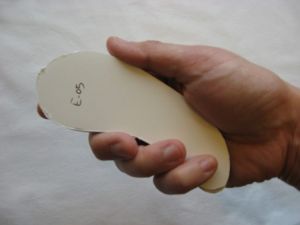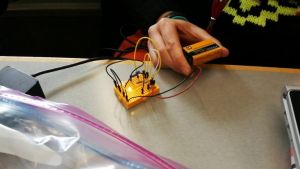Project Description
Master Classes are deep dives into venture creation by MIT ecosystem thought leaders. Browse all Master Classes Here.
During the coronavirus crisis, access to makerspaces and machine shops can be severely disrupted. If you are building a hardware product, that can feel very disruptive. Don’t panic! You can still make progress – as long as you have a little budget and a bit of extra time.
Lower your fidelity expectations for your DIY mechanical prototypes
If your home is not equipped with 3D printers and a full on hobby shop, you can still build prototypes by hand using easily sourced raw materials, found objects and household items. You can work on all of the above using hand tools readily available at home. Examples include building quick form prototypes with cardboard, foamcore, foam and clay. This technique is particularly helpful if you are trying to get a quick sense of the human factors element of a hand held object.

You can even prototype mechanisms using cardboard or foamcore, using found objects such as paper clips and machine screws and nuts to serve as rotary joints. This is a good way to get an intuitive feel about the workspace of an articulated linkage design – even if you do have access to a full-fledged machine shop.

Making parts with a consumer grade 3d printer
If you have a 3d printer at home that can create parts with PLA or other such materials, you can do a lot more with CAD. Of course this only works if you have access to a supply of PLA (the raw material that a lot of consumer-grade printers use to build parts with).

As long as you can use CAD and print parts, you can design and print an A-B mold, then cast your part with either silicone or liquid plastic molding supplies with your hand made mold.
All of the above assumes that you are able to procure the raw materials. Look into the availability of these raw materials before you make firm plans.
Making sheet metal or machined metal parts
If you need CNC machined parts, you really don’t have much choice. You will need to outsource to your friendly R&D machine shop. See takeout section below.
Electronics hacking
On the electronics side, so long as you have a breadboard, jumper wires, batteries, and access to basic sensors and actuators, you can hack basic circuitry at home without being able to solder.

If you have a soldering iron as well as soldering supplies at home, you can build higher fidelity PCB prototypes by working with perforated boards and through-hole electronic components. Make sure you do it in an area with good ventilation!
Surface mount is the only thing that is really difficult to do at home without proper equipment. Even then, you could do a bit of work if you have a good soldering iron with a very fine tip (the author has done SMT PCBA rework on 50 boards by hand once, replacing a surface mount resistor. It was painful and requires good eyesight and a steady hand. I do not recommend it, but it can be done.)
Firmware
Firmware is easily done at home with the right development kit. For amateur making and hacking, Arduino and Raspberry Pi are two great platforms for rapid prototyping.

For people doing more serious product development developing code designed to run on a production-level microprocessor (e.g. a variant of a Cortex architecture microprocessor), most manufacturers sell development kits which should be your go-to platform for code development anyways.

Getting “takeout” for custom parts
While there are many options for at-home making and hacking on the mechanical, electronics and firmware/software side of things, at some point, you may need equipment that is not available to you.
In that event you can do what people used to do for product development 10 years ago (before the widespread availability of rapid prototyping equipment in ordinary makerspaces): Get “takeout”. It will take longer from an elapsed time standpoint. It is also cash out of pocket. But think of all the time you would have saved that you can now spend on actual engineering design!
Pro tip: This is how actual product development is often done in real life because it is too slow to make these parts yourselves. In a company developing manufacturing-intent parts of reasonable complexity, it is rarely worth spending the time of a mechanical engineer on the physical making and hacking once there is a system architecture design in place. It makes much more sense to send the parts out to be made while the engineer spends their time designing the next parts.
- For laser cutting: Most people don’t have access to a laser cutter. Some on-line players that turned up in a quick search include: Ponoco, Sculpteo and Cotter.
- For making low quantities of 3d plastic parts (1-10): There are many vendors that will allow you to upload a 3D file (typically in .STL format), choose a material or a process, and have that part custom made and sent to you with a 2-3 day turnaround. In 2020, some example vendors who do turnkey RP part printing / production include: Stratasys Direct, 3D Systems On Demand, which are service businesses supported by companies that make RP equipment (Stratasys and 3D systems). There are also other additive manufacturing providers who are not attached to any one manufacturer. This includes: Xometry, 3D Hubs as well as regional players like InterPro Rapid Prototyping in the East Coast and SiCAM in the midwest.
- For making slightly larger quantities of plastic parts (10-50): 3D printing or other additive manufacturing processes are good for small order quantities. When you need to make 50+ of something, urethane casting is a better alternative. Many of the RP providers listed above also provide this service. Check with these providers to see what they can cover.
- For making large numbers of plastic parts (1000 and above): Consider using a low volume injection molding provider such as Protomold by Protolabs.
- For metal parts (sheet metal, CNC machined parts) of any quantity: Consder one of the RP providers – e.g.Xometry and Protolabs.
Note that during the coronavirus pandemic of 2020, many providers are running at full capacity producing mission critical parts such as ventilator adaptors and face visors to support front line medical workers. Also, due to travel disruption, shipping times may be longer than expected. Call your provider to make sure they are open and to get a sense of the turnaround time.
Additional note during this time of global supply chain disruption: There are components that are single sourced from China. For those components, you may find it difficult to buy them on demand. If you are able to buy them from Stateside distributors who still have inventory, go for it – and you may need to do a risk-buy of a greater quantity than what you need right away so you have enough to work with for a few months. Anything that used to be drop-shipped from China/APAC will experience severe delays, and in some cases, they may not be able to get here at all, due to disruption in transportation in addition to production facilities not operating at full capacity. Take note of that when you plan your purchasing activities.
For your convenience, Mac Cameron, master maker, Lecturer at the Trust Center and lead instructor of Introduction to Making, 3D Printing and more, has created a quick one-page cheat sheet of companies you can work with to get your prototypes produced. Information on this cheat sheet is current as of July, 2020. Check it out.
As with any outsourced services, you should always comparison shop. Upload the exact same part (in STL format) to multiple suppliers and see what materials, lead times and costs they are able to quote – then pick the provider that meets your needs.
A version of this article first appeared on the ConceptSpring blog by Elaine Chen.
